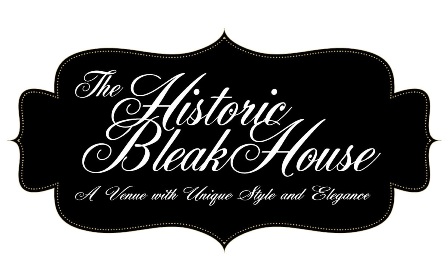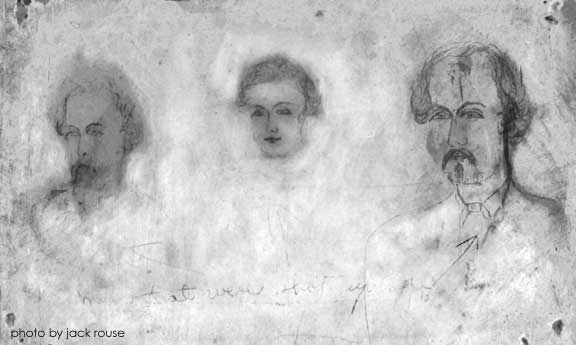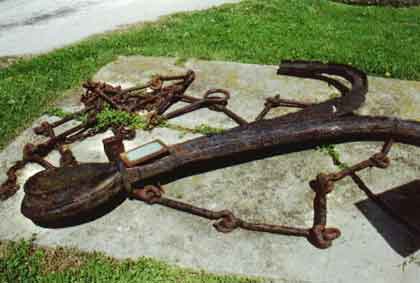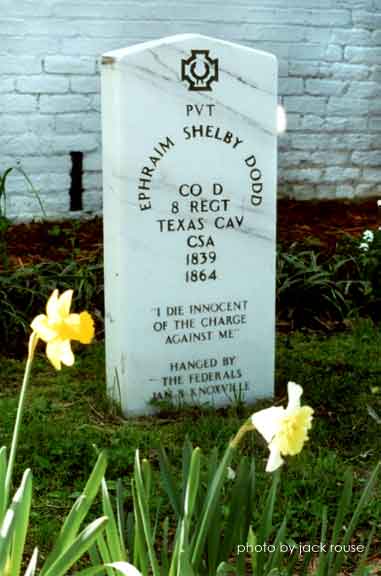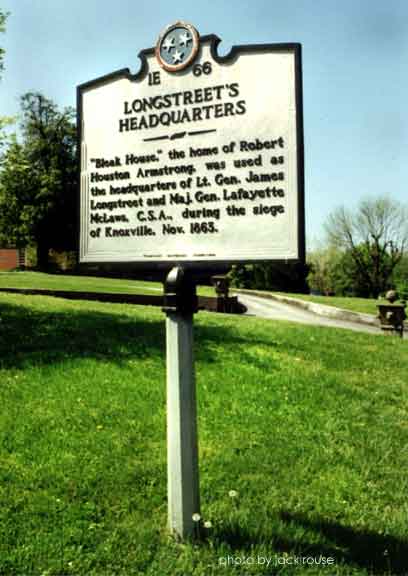Confederate Memorial Hall, originally named Bleak House, has a rich and interesting past. This is a brief history of this warm and wonderful mansion... |
||
Bleak House in 1858
Bleak House now
Drawing in Tower: “Men that were shot up here”
Homemade blockade anchor and chain – 1863 Read more about the anchor and the Battle of Knoxville at these links: Adobe Acobat Reader Required - Download for free:
A sad story
Historical marker on front lawn
|
Confederate Memorial Hall, originally named “Bleak House,” has a rich and interesting past. This is a brief history of Bleak House, including some significant events in which Bleak House and its owners and visitors were intimately involved. Bleak House, an antebellum mansion of fifteen spacious rooms and wide halls, stands well back on an eminence among lovely trees and elaborately landscaped grounds. The property fronts 250 feet on Kinston Pike and extends over 900 feet in terraced gardens down to Fort Loudon Lake (Tennessee River). The house was built for Robert Houston Armstrong and Louisa Franklin as a wedding gift. Louisa’s father, Major L. D. Franklin, built the house; Robert’s father, Drury Armstrong of Crescent Bend, donated the land. The young couple named their stately home, “Bleak House,” for Charles Dickens' then currently popular novel of that name. The house remained in the Armstrong family until 1906 when it was sold to Mr. and Mrs. John Scruggs Brown. The Browns further beautified the house and created the lovely Roman gardens, including the elaborate fountains and ponds. Mrs. Brown sold the property in 1936 to Mr. and Mrs. Roy N. Lotspeich, prominent Knoxvillians. Knoxville Chapter 89, United Daughters of the Confederacy (UDC), acquired the property on May 4, 1959, for use as a Confederate Memorial, museum, and chapter house. The house, which was a focal point during the War Between the States, is a fine example of the Southern antebellum mansions that are rapidly vanishing from Knoxville and other areas of the South. During the siege of Knoxville by the Confederates under General James Longstreet, November 17 to December 4, 1863, Bleak House was the headquarters of General Longstreet and his staff. A first-hand account of the occupation and the fighting around her home was told in a letter written by Mrs. Louisa Armstrong and published in the Knoxville Journal and Tribune on September 27, 1898. She told how Longstreet had cannons placed on the front lawn, surrounded the house with pickets (guards), and placed sharpshooters at the windows from which the enemy was plainly visible, especially from the tower windows. She said that the shot from one of the windows fatally wounded General William P. Sanders, who was several hundred yards away. A 20-pound shot that failed to explode tore out a large section of the brickwork of the northeast front room. Windows were broken and nearly every wall had bullet marks (still visible today). One sharpshooter was killed in the tower. Portraits of three unnamed Confederates, drawn on one wall by an unknown soldier artist, are mute evidence today that soldiers were killed or wounded in the tower. The artist wrote under his pictures the line, “Men that were shot up here.” These strikingly different faces are remarkably well preserved after over 140 years. The tower, closed and the entrance sealed for many years, was reopened by the UDC, and a new stairway was built. Much has been done toward maintaining the house and grounds and restoring them to their original grandeur and elegance. The entire house is furnished with museum pieces, and the Chapters’ large collection of pictures and paintings of historical interest are on display. The museum contains a continuously growing collection of priceless relics of early Southern Culture. The extensive library, containing many first editions of Southern literature and history, is located in a spacious room on the second floor. The Chapter has 501(c)(3) status with the IRS, and the property has been listed on the National Register of Historic Places since 1984. For in-depth information, schedule a tour of the house and grounds. Well-informed hostesses will tell you as much as you care to know – and give an interactive guided tour. For information on tours click on “Tour and Reservation Info” on the home page or call (865) 522-2371. (All restoration work and photos on this page by Jack
Rouse) |
|

